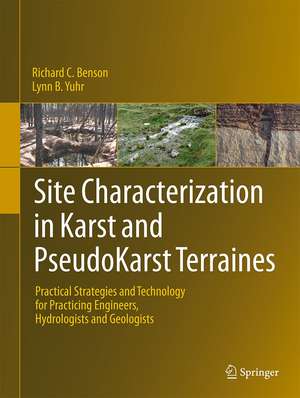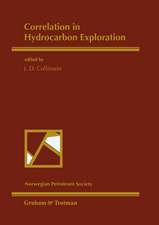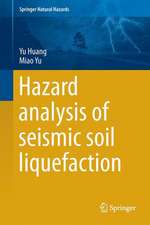Site Characterization in Karst and Pseudokarst Terraines: Practical Strategies and Technology for Practicing Engineers, Hydrologists and Geologists
Autor Richard C. Benson, Lynn B. Yuhren Limba Engleză Hardback – 5 oct 2015
The purpose of a geologic site characterization is to understand the 3-dimensional geologic framework, along with the engineering and hydrologic properties of a site including any man-made impacts. A well-done site characterization is the cornerstone of all geotechnical, groundwater and environmental projects. The geologic conditions, particularly karst conditions, can significantly impact a site including its structural stability, groundwater pathways and potential for rapid transport or traps for contaminants. Once we have adequately characterized the geologic conditions can we carry our remediation, design and construction, model flow, and make risk assessments that are accurate and reliable.
| Toate formatele și edițiile | Preț | Express |
|---|---|---|
| Paperback (1) | 746.41 lei 6-8 săpt. | |
| SPRINGER NETHERLANDS – 23 aug 2016 | 746.41 lei 6-8 săpt. | |
| Hardback (1) | 628.53 lei 38-45 zile | |
| SPRINGER NETHERLANDS – 5 oct 2015 | 628.53 lei 38-45 zile |
Preț: 628.53 lei
Preț vechi: 775.96 lei
-19% Nou
Puncte Express: 943
Preț estimativ în valută:
120.27€ • 128.61$ • 100.28£
120.27€ • 128.61$ • 100.28£
Carte tipărită la comandă
Livrare economică 14-21 aprilie
Preluare comenzi: 021 569.72.76
Specificații
ISBN-13: 9789401799232
ISBN-10: 9401799237
Pagini: 280
Ilustrații: XVII, 421 p.
Dimensiuni: 210 x 279 x 27 mm
Greutate: 1.61 kg
Ediția:1st ed. 2016
Editura: SPRINGER NETHERLANDS
Colecția Springer
Locul publicării:Dordrecht, Netherlands
ISBN-10: 9401799237
Pagini: 280
Ilustrații: XVII, 421 p.
Dimensiuni: 210 x 279 x 27 mm
Greutate: 1.61 kg
Ediția:1st ed. 2016
Editura: SPRINGER NETHERLANDS
Colecția Springer
Locul publicării:Dordrecht, Netherlands
Public țintă
Professional/practitionerCuprins
1. Some Common Terms.- 2. The Development of Karst Conditions.- 3. Types of Karst Features.- 4. Karst Maturity and Development.- 5. Areas Affected by Karst and Pseudokarst.- 6. Karst and Its Many Benefits.- 7. Karst and Its Damaging Impact.- 8. Triggering Mechanisms for Sinkholes.- 9. Cave and Cavern Collapse.- 10. Insight into the Nature of Cover Collapse Sinkholes.- 11. What is Site Characterization.- 12. The Strategy.- 13. The Desk Study.- 14. Aerial Photography and Remote Sensing Data.- 15. Site Walkover.- 16. Surface Geophysical Methods.- 17. Invasive Methods.- 18. Geophysical Logging.- 19. Assessment of Larger Open Voids and Structures.- 20. Engineering Measurements and Monitoring.- 21. Hydrologic Characterization and Measurements.- 22. Dye Tracing.- 23. The Conversion of Data to Useful Information.- 24. Risk Assessment.- 25. The Development of a Landfill Over an Abandoned Limestone Mine.- 26. Site Characterization along Bridge Alignment.- 27. EPA Superfund Site.- Index.
Notă biografică
This book is, for the most part, based upon the authors combined experience of more than 80 years as consulting geologists. The authors are a father and daughter team, who have worked together since 1978 providing consulting services through their company Technos, Inc. Their hands-on experience in site characterization, with both karst and pseudokarst, is represented by the many technical examples included in the book.
Textul de pe ultima copertă
This book provides a practical strategy for obtaining a more complete and accurate geologic site characterization. The strategy and methods to characterize complex geologic settings are readily available. The strategy utilizes readily available technology, basic science and good, old-fashioned common sense resulting in a solid understanding of geologic and even karst or pseudokarst conditions. We provide an introduction to many off-the-shelf methods available for site characterization as well as examples of their application throughout the book.
The purpose of a geologic site characterization is to understand the 3-dimensional geologic framework, along with the engineering and hydrologic properties of a site including any man-made impacts. A well-done site characterization is the cornerstone of all geotechnical, groundwater and environmental projects. The geologic conditions, particularly karst conditions, can significantly impact a site including its structural stability, groundwater pathways and potential for rapid transport or traps for contaminants. Once we have adequately characterized the geologic conditions can we carry our remediation, design and construction, model flow, and make risk assessments that are accurate and reliable.
The purpose of a geologic site characterization is to understand the 3-dimensional geologic framework, along with the engineering and hydrologic properties of a site including any man-made impacts. A well-done site characterization is the cornerstone of all geotechnical, groundwater and environmental projects. The geologic conditions, particularly karst conditions, can significantly impact a site including its structural stability, groundwater pathways and potential for rapid transport or traps for contaminants. Once we have adequately characterized the geologic conditions can we carry our remediation, design and construction, model flow, and make risk assessments that are accurate and reliable.
Caracteristici
Provides a practical approach to fill a gap between the engineers and geologists Provides useful strategies and readily available methods to solve difficult site characterization issues Identifies weak links and problems in achieving a complete and accurate site characterization Utilizes mini-case histories and examples to illustrate the wide variety of methods that can be used Provides three complete case-histories of significant site characterization and risk assessment in karst





















